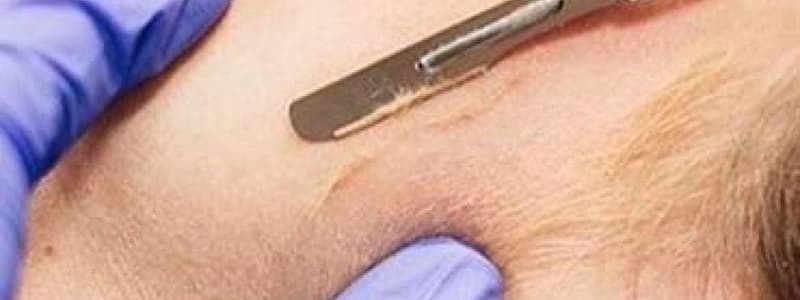Podcast
Questions and Answers
Which type of hair is the longer, thicker, and darker hair that grows on the head?
Which type of hair is the longer, thicker, and darker hair that grows on the head?
- Terminal hair (correct)
- Vellus hair
- Peach fuzz
- Lanugo hair
What is the primary role of vellus hair?
What is the primary role of vellus hair?
- To grow longer
- To protect the skin and keep the body warm (correct)
- To lubricate the skin and hair
- To strengthen the hair
When does lanugo typically develop in most fetuses?
When does lanugo typically develop in most fetuses?
- First month of pregnancy
- Fourth or fifth month of pregnancy (correct)
- Third month of pregnancy
- Second month of pregnancy
What happens to lanugo hair in all babies?
What happens to lanugo hair in all babies?
Which of the following is a benefit of EpiBlading?
Which of the following is a benefit of EpiBlading?
Which of the following is an absolute contraindication for EpiBlading?
Which of the following is an absolute contraindication for EpiBlading?
What is the purpose of the initial consultation for EpiBlading?
What is the purpose of the initial consultation for EpiBlading?
According to the Fitzpatrick Skin Type classification, which skin type is characterized by always burning and never tanning?
According to the Fitzpatrick Skin Type classification, which skin type is characterized by always burning and never tanning?
Which of the following best describes EpiBlading?
Which of the following best describes EpiBlading?
What is the purpose of using skin scanners (woods lamp) and taking photos prior to EpiBlading treatment?
What is the purpose of using skin scanners (woods lamp) and taking photos prior to EpiBlading treatment?
Which core value is emphasized in the training program?
Which core value is emphasized in the training program?
What does EpiBlading stimulate?
What does EpiBlading stimulate?
Which of the following is the primary indication for performing EpiBlading?
Which of the following is the primary indication for performing EpiBlading?
What is the purpose of using Barbicide to sanitize non-disposable equipment?
What is the purpose of using Barbicide to sanitize non-disposable equipment?
What is the main difference between EpiBlading and shaving?
What is the main difference between EpiBlading and shaving?
What are the benefits of EpiBlading on the skin?
What are the benefits of EpiBlading on the skin?
Which of the following is NOT a recommended blade for EpiBlading?
Which of the following is NOT a recommended blade for EpiBlading?
How often should EpiBlading treatments be performed for regular exfoliation and vellus hair removal?
How often should EpiBlading treatments be performed for regular exfoliation and vellus hair removal?
What should be done if bleeding occurs during an EpiBlading treatment?
What should be done if bleeding occurs during an EpiBlading treatment?
What is the purpose of applying serum, masks, eye cream, moisturizer, and sunscreen after an EpiBlading treatment?
What is the purpose of applying serum, masks, eye cream, moisturizer, and sunscreen after an EpiBlading treatment?
Which type of hair is stronger and thicker, such as the hair on your head and pubic regions?
Which type of hair is stronger and thicker, such as the hair on your head and pubic regions?
What is the main difference between vellus hair and terminal hair?
What is the main difference between vellus hair and terminal hair?
What happens to vellus hair at puberty?
What happens to vellus hair at puberty?
Can cutting or shaving vellus hair change the structure of the hair follicle?
Can cutting or shaving vellus hair change the structure of the hair follicle?
Is EpiBlading a painful procedure?
Is EpiBlading a painful procedure?
Flashcards are hidden until you start studying
Study Notes
EpiBlading Training Notice: Key Points
- EpiBlading is a non-invasive, painless treatment that involves gentle mechanical exfoliation using a special butter blade held at a 45-degree angle.
- The treatment stimulates cellular turnover, increases fibroblast activity, hydration, collagen, elastin, and circulation, and temporarily removes vellus hair.
- EpiBlading is suitable for various skin concerns such as dull or dry skin, uneven complexion, enlarged pores, fine lines, scarring, and vellus hair removal.
- Absolute contraindications for EpiBlading include active infections, cold sores, inflamed or broken skin, uncontrolled diabetes, contagious skin disorders, cancer, and certain medications.
- The initial consultation is important to understand the client's goals, explain the procedure, and recommend appropriate home care products.
- Fitzpatrick skin type classification is commonly used to determine a person's response to sun exposure and can help guide EpiBlading treatment.
- Lanugo hair is the first type of hair that grows on a fetus, while vellus hair is the light, short, fine hair that covers much of a person's body.
- Terminal hair is longer, thicker, and darker hair that grows on the head and other parts of the body after puberty.
- Both vellus and terminal hairs have three growth phases: anagen (active growth), catagen (transition), and telogen (resting).
- EpiBlading offers physical exfoliation, removes vellus hair, increases product penetration, and is safe for telangiectasia.
- Proper hand position and maintaining a 45-degree angle during EpiBlading are important for optimal results and precise control of the blade.
- It is important to use correct single-use, surgical blades for EpiBlading and dispose of them in medical sharps waste.
Studying That Suits You
Use AI to generate personalized quizzes and flashcards to suit your learning preferences.
